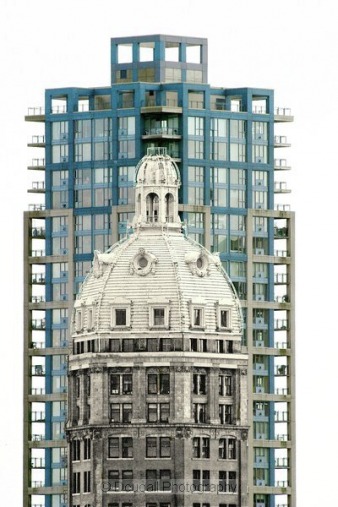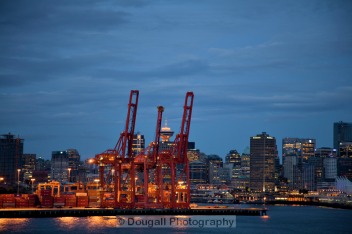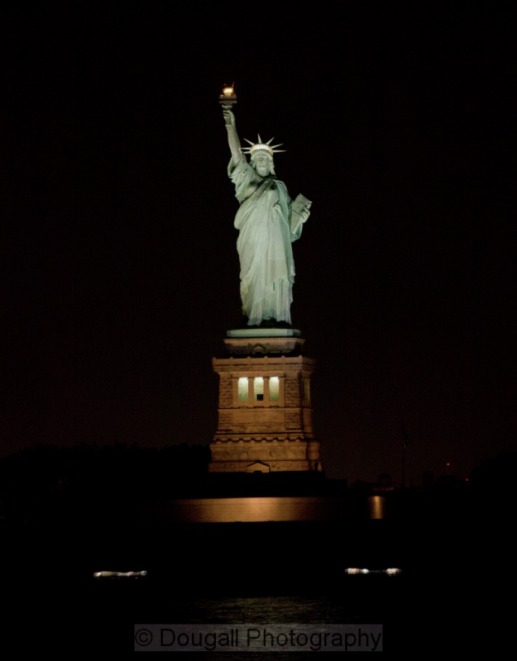|
Maison Jacquet, built between 1675 and 1676, is the oldest house in Quebec City and is now the home of Aux Anciens Canadien Restaurant
Eight o'clock at night and pitch black. Canon 70-200mm 2.8 IS lens at 200mm on a moving cruise ship. ISO 6400 - yes, there is noise all over the place in the photo! Shutter speed 1/90 @ f/2.8. I can't believe that I was actually able to capture anything remotely this sharp in what amounted to a full on, hand held night shot.
The quaint fishing village of Peggy's Cove, located west of Halifax, Nova Scotia, is one of the most popular places for tourists to visit in Maritime Canada. There are usually so many tourists visiting during the summer that getting a photo with no one in it is a bit of a challenge. This stretch of shoreline is behind the popular light house and, with no one else about, allowed me to capture a more tranquil scene than is usually possible.
As Jan and I explored the streets of historic Boston, one of the things we noticed was the fire alarm pull boxes on some of the street corners. They were well maintained and obviously an important element in the protection of neighbourhoods and buildings from fire. We couldn't resist the bright red color of the boxes or the large, red globe on top! This one was located on the corner of Snow Hill and Hull Streets, about a block northwest of the Old North Church.
The Portland Head Light located surprisingly, in Cape Elizabeth, Maine, is probably one of the most photographed lighthouses in the United States. There has been a light in this location since the 18th Century and was not automated until 1989.
Shot from the terrace of the Novotel on Broadway and 52nd Street in the Times Square district of New York. I was looking for a way to compress all the activity and advertising that washes over you in this part of the city. It doesn't seem to matter if you are on the street in the middle of the day or the middle of the night, there is always a flurry of activity with people and vehicles always on the move.
 Sun Tower and Paris Place, Vancouver If you are lucky enough to sail from the Port of Vancouver and your ship is docked at Canada Place, you will see a panorama of old and new architecture spread out in front of you. Most of this diversity is in the lower east side of the city as you can find old and new buildings visibly a part of the cityscape. On the west side of the city, the good burghers of Vancouver have allowed huge glass towers to obliterate any view of the older, more interesting buildings that now simply make up the understory of the urban forest. The building in the foreground is the Sun Tower (originally the World Building), built in 1912 and, at 17 stories high, was the tallest building in the British Empire at the time of its construction. The cornice is adorned with sculptures of semi-nude women which was a major scandal in 1912. The building has been renamed several times and has been recently renovated to remain desirable office space. The building in the background is Paris Place, a 33 story condominium block built in 1996. Paris Place, while towering over the Sun Tower, is still only the 37th tallest building in Vancouver at 101 meters. Currently the tallest building in Vancouver is the Shangri-La at 201 meters. I chose to emphasize the age differences between these two buildings by desaturating the Sun Tower which also separates the foreground from the background in a more apparent manner. As new buildings have been constructed since this image was taken, you really can't replicate this view very well, but I am pleased to have old and new architecture in the same image as I think it represents the dynamic and changing nature of the Vancouver skyline.  This photo was taken several years ago on our approach to Hubbard Glacier. I was using a Canon D30 at the time - the leading edge of pro/am camera gear with a huge 3MP sensor in it. This is a stitched panorama with four or five images used to create the final image. The actual printed image is about four feet across and looks good (and cold) hanging on our wall at home. We were very lucky on the day of our visit as the weather was beautiful and, in spite of the "bergy bits" and "growlers", we made a close approach to the face of the glacier where the Captain spun the ship so that everyone had a good view of the ice. Some claim that viewing a glacier is better on an overcast day as the deep blue of the ice can be better seen. That may be true, but the hot sun beating down on the ice face causes more frequent "calving". That day the thunderous sound of ice separating from the glacier face was constant and loud. The weather in front of Hubbard is quite changeable - we have been there in rain, in fog so thick it would hide and entire cruise ship and in temperatures so cold you would think you are standing in a walk-in freezer. Glaciers like this are so large they generate their own weather and the run in to the face of the ice takes the ship through strong, cold winds blowing off the glacier and straight at an approaching ship. It's not until you are within miles of the glacier that the ship finds calm air and, if the sun is out, far warmer conditions. If you are going to be visiting Hubbard Glacier, bring something warm to wear, It may be warm in the rest of Alaska, but standing in front of a 6 mile wide glacier is like standing in front of the largest air conditioner in the world!  This is one of my favourite photos of a local powwow dancer. Most powwows around Saskatoon are outdoor events - this is one of the few that I have been asked to photograph that was inside. I was grateful for the harsh lighting inside the arena as it provided high key lighting on the dancers while throwing the background into an inky blackness. Even with a high speed telephoto, I was still working at the extreme edge of shutter speeds that would render the dancers in focus. After I had a number of sharp photos "in the bag", I decided I would drag the shutter at a much lower speed to try and give a sense of motion to some photos. This is one of the best of the day as far as I am concerned. Showing the photos to the dancers after the powwow there was universal agreement that this photo captured the spirit of the dance.  Vancouver Dawn One of the least appreciated photo opportunities on a round trip sailing out of Vancouver is an early morning cruise under the Lion's Gate Bridge and up Burrard Inlet. City buildings will either be lit up in the pre-dawn darkness or the sun will be rising behind them, casting an arc weld bright light across Coal Harbour. On this arrival, the ship was headed for Ballantyne Pier to the east of the usual Canada Place dock. The route to the pier takes the ship right by the main Port of Vancouver docks which are lit up during the night. I am always amazed at how quietly such a large ship slips through the water so close to shore. It barely moves and is virtually silent in its progress. The cargo cranes were wonderfully lit that morning and looked like artists' sculptures sitting on the shore. The last morning of a cruise is a sad time as we contemplate leaving "the bubble" for the real life of shore so it was a nice perk to have this great view just before we had to disembark! |
Dougall Photography
Blog Archives
June 2018
Blog Categories
All
|







 RSS Feed
RSS Feed
